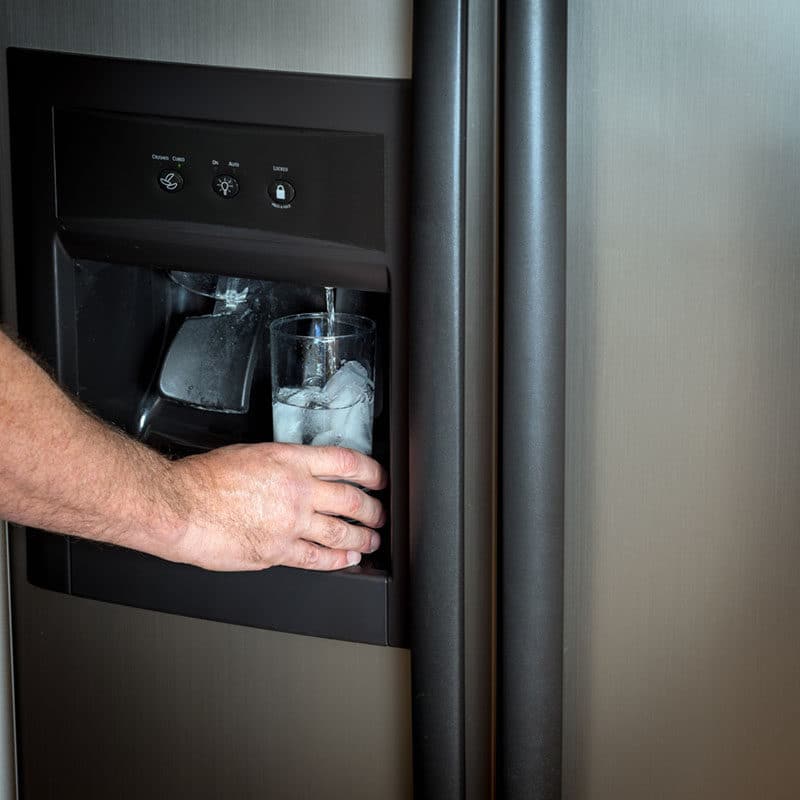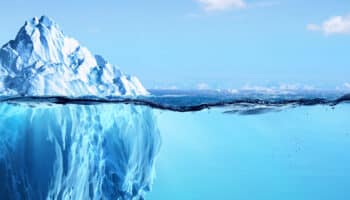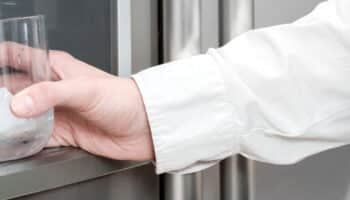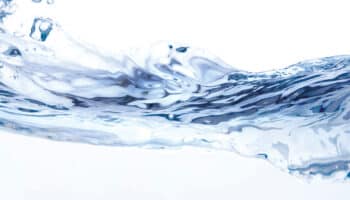Wondering why your ice maker keeps overflowing with ice? I did too. After dealing with yet another watery ice spill, I looked into solving the problem myself, and now I want to help you.
The most common reasons why refrigerator ice makers overflow with too much ice are that the water pressure is too low or there’s a defective valve somewhere. The issue can also be related to a problem with the ice chute.
If you want to fix your ice maker, you need to figure out which one applies to you.
So, are you finally ready to fix your overflowing ice maker? Let’s dive right in!
Why trust us? This article was written by Craig Anderson and Andy Fulenchek.
Craig has helped thousands of other homeowners repair their appliances since 2016.
Andy is one of our resident appliance repair experts with over a decade of experience. He currently runs his appliance repair company with a team of trusted technicians.
How Ice Makers Produce Ice
Before we can determine why your ice maker is overflowing, it’s important to learn more about how refrigerators produce ice:
- Your refrigerator is connected directly to your home’s drinking water supply. There’s water that flows from the water supply into the ice maker.
- Water fills up the mold in your ice maker, producing ice cubes.
- If you decide you want crushed ice, there’s a motor mechanism responsible for crushing the ice cubes.
- Once crushed, ice flows through the chute and into your glass.
In my experience, if your refrigerator’s ice maker is overflowing with water, it’s a sign that your refrigerator is producing ice when it’s not supposed to.
Your refrigerator should have a sensor on the inside. The sensor is responsible for telling the rest of the system when the ice maker is full. When the ice maker is full, the water flow valve is supposed to stop, keeping the refrigerator from making ice when it is not supposed to.
Having covered the basics of ice maker functioning, let’s see why your ice maker is overfilling with ice.
The Most Common Reasons Why an Ice Maker Overflows with Ice
If you find that your ice maker is overflowing with ice, there are several possible causes you need to explore. These include:
Check the Location of the Ice Bin
First, there’s a chance that only the ice bin is overflowing. You must ensure the refrigerator’s ice bin is in the right place. I find that if the bin hasn’t been placed properly underneath the ice maker, it’s easy for ice to spill over the side of the storage bin.
As a result, ice won’t fall inside the bucket. In such a case, it can look like your ice maker is overflowing. If you see a bunch of ice cubes on the ground, check the ice bin’s positioning and ensure it has been positioned appropriately.

Inspect the Feeler Arm
When your ice maker is overflowing with water or ice, it’s possible that there’s something wrong with the feeler arm, which acts as the sensor for your ice maker. If the feeler arm has been broken, your ice maker cannot know when the bucket is full.
If the ice maker cannot detect a full bucket, it will continue to produce ice, and eventually, the storage bin will overflow. Luckily, it’s relatively easy to replace the feeler arm. If you notice the feeler arm is broken, my usual advice is to contact a professional to help you replace it.
Alternatively, if you have a lot of experience working with ice makers, the repair is something you can do yourself. Once you fix the feeler arm, your ice maker should start working properly.
The Water Pressure Is Too Low
The next step to try when your ice maker is overfilling is to check the water pressure, as it could be a bit low. If you have low water pressure throughout your home, it can be frustrating when you try to shower or take a bath, but it doesn’t stop there. Low water pressure is also something that can impact your ice maker.
Your ice maker’s water inlet valve requires at least 20 PSI to work properly. If the inlet valve is not sensing the minimum water pressure, it won’t close all the way when the water is supposed to stop flowing. As a result, the water will continually drip into the ice maker.
When there’s not enough water pressure to close the valve, your ice maker receives far too much water, which can overfill it and freeze it completely.
If you look at your ice maker and all you see is a singular sheet of ice, there’s a chance that low water pressure is the issue. You must look closer and check your water pressure to ensure it’s appropriate. If not, you must increase the pressure so your ice maker can work properly.
You’ll also want to check for a clog in your pipes, as it could be the reason why the water pressure is too low.
The Water Inlet Valve Is Defective
A faulty or stuck water valve could also explain why your ice maker is overflowing with water or ice. If you find that your water pressure is normal, it’s likely that the water valve is at fault. But before you blame it all on the valve, please ask yourself, is there hard water in your area?
Hard water is a specific type of water that some homes and areas have. Hard water has high mineral content, which can form limescale on water valves, faucets, and shower heads over time and might explain why your ice maker is overfilling.
Check for any signs of sediment on your ice maker. If you spot none, I recommend you turn your attention to the water inlet valve. The valve may not be closing completely, allowing for a continuous flow of water into the ice maker.
Luckily, fixing a faulty or stuck water valve is simple. If you have experience working with your ice maker, you may be able to swap out the water inlet valve yourself, but if not, please call a technician for help.
If you decide to replace the water valve yourself, you’ll need what’s known as a “Joint Guest Fitting”. You must ensure the new valve sits in the fitting perfectly. The repair can range from $180-$350, depending on the complexity of the valve.
If you want to get any replacement part – or see how much one would cost – click to enter your model number in the search bar below. Our partners at AppliancePartsPros stock almost every part with free guides on how to install them.

The Chute in the Ice Maker Is Clogged
The chute might be clogged if your ice maker keeps overflowing with water or ice. If the chute is clogged, ice won’t be able to flow out of the ice maker. As a result, ice will back up into the storage bin, causing it to overflow.
As your refrigerator continues to produce more ice, the storage bin will continue to fill up. Eventually, your ice cubes will start to stick together, creating a single sheet of ice.
I’ve found that cleaning the chute often can prevent clogs from forming in the system. Cleaning your ice maker’s chute is easy. You simply need water, a vinegar solution, and a damp cloth.
The Heater is Faulty
If your ice maker’s heater is faulty, it could also explain its overfilling. I know it’s strange to hear that an appliance designed to make ice needs a heater, but how else will the ice cubes come off their mold and into the bin?
Your ice maker’s heater pre-melts the ice cubes it creates to make the process simpler. However, when the heater fails, ice can stick to the mold. As you push the button for more ice, the ice maker will produce it, but since there’s already ice stuck on the mold, it’ll just overflow.
Unfortunately, if your ice maker’s heater is failing, you’ll have to replace the ice maker altogether. Depending on the refrigerator brand and model you own, the replacement can be a simple DIY or a complex process that requires a professional.
A new ice maker can cost anywhere between $175-$400.
If you want to get any replacement part – or see how much one would cost – click to enter your model number in the search bar below. Our partners at AppliancePartsPros stock almost every part with free guides on how to install them.

Prevent Future Problems with the Ice Maker
Having covered the most common causes and symptoms of an ice maker overfilling, let’s look at some good practices you can implement to prevent problems in the future.
- Invest in Regular Plumbing Maintenance: Ensure your plumbing system is maintained frequently to identify issues with your water pressure and prevent limescale buildup due to hard water.
- Clean Your Ice Maker: Cleaning your ice maker frequently can prevent several issues and yield better-tasting ice. Leaving your ice bin to defrost in the sink occasionally can also go a long way.
- Be Careful With the Ice Maker: Avoid using sharp objects to break up the ice clumps. If you use sharp objects, you could mistakenly go right through the ice and damage the ice maker, breaking the water inlet valve or the feeler arm.

Dealing With an Overflowing Ice Maker
Even though there are lots of possible reasons why you might have an overflowing ice maker, the reasons mentioned above are the most common. Remember to ensure the ice bin is positioned properly underneath the ice maker and that the feeler arm is working properly.
Also, check that the water pressure is high enough and that the water inlet valve isn’t damaged. Looking closely at your ice maker and its components will go a long way in preventing issues in the future.
Thanks for reading. If this article has helped you, why not check out some of our other resources and free guides below? You can even sign up for our email list.
Have a great day!
-Craig.








